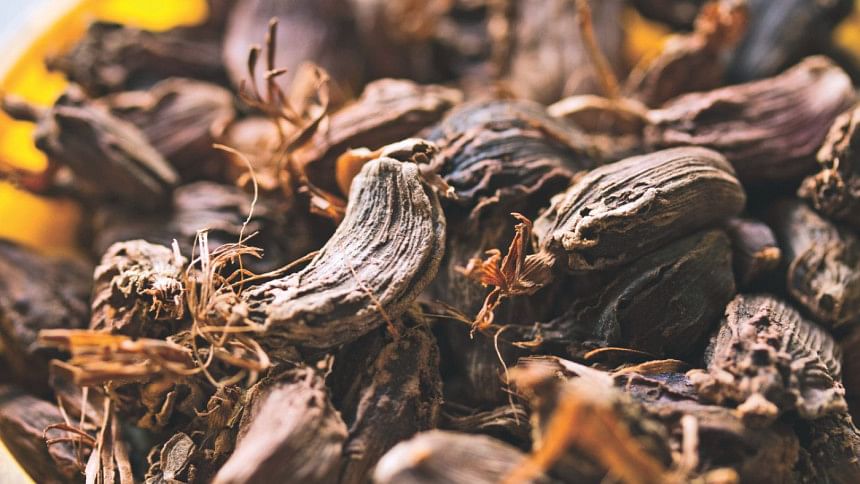Black Cardamom

Biting into one of these during meals has to be one of the worst feelings ever, yet it is found in pretty much every dish, sweet or savoury. Not only does the black cardamom do a great job at adding a heap of flavour to foods, its nutritional values are too long to list down.
Nutritional values
The black cardamom is a great source of minerals such as manganese, iron, copper, magnesium, potassium, zinc and phosphorous. It also has Vitamins C and B complex. Being low in sodium and zero cholesterol is another reason people love it, as well as because of its essential oils, which aid in a lot of health problems in the body.
Lowers blood pressure
High blood pressure is a common problem in the developing world, and anything that can beat it should be on our radar. The black cardamom has a ton of antioxidant properties, which are known to help lower blood pressure.
Better breath
Black cardamom can fight mouth bacteria, relieving you of bad breath, which is one reason people like to chew on it after meals. As it fights mouth bacteria, it can also prevent cavities, so there's another reason.
It has diuretic effects
Black cardamom has the ability to increase urination in one's body when there is excess water build-up anywhere in the body, otherwise known as a diuretic effect.
Antioxidant rich
Antioxidants are that one thing we like to look for in everything these days, from food to beauty products. Lucky for us, the black cardamom is loaded with it, which helps deal with a ton of body issues. The antioxidants help our body prevent inflammations and allows faster cell repair.
Relaxes lungs
This is good news for people suffering from asthma, because black cardamom relaxes airways, allowing the lungs to more effectively take in oxygen.
Treats infections
Cardamom essential oils work magic against some of the most common bacteria known to us. It can help fight E.Coli and Salmonella, and prevent food poisonings according to Health Line. Since this condiment can fight against numerous strains of bacteria, it also helps to treat infections.
Better digestion
Black cardamom helps in aiding our digestion, from relieving nausea right down to helping the stomach and its troubles.
Consumption
The safest way to incorporate black cardamom without having to worry about any side effects is to use it in its natural form and avoid supplements unless prescribed by a professional.
If you are looking for a new and fun way to incorporate the black cardamom into your recipes, give these unique ideas a try.
SMOKY VANILLA COFFEE ICE CREAM
Serving: 3/4 litre
Ingredients
1½ cups heavy cream
¾ cup whole milk
3 black cardamom pods
½ vanilla bean (or 1 tsp of vanilla extract)
3 tbsp instant coffee
2 egg yolks
1/3 cup raw sugar
1/4 tsp gelatin (or equivalent)
Method
Crack open the black cardamom pods, and put the empty pods into a small pot, and the seeds into a mortar. Grind the seeds into a fine powder and transfer it to the small pot. Slice open the vanilla bean and scrape out the seeds with the dull side of the knife. Add the seeds and the pod into the small pot. Next add the cream, milk, and instant coffee into the small pot. Using a heat resistant plastic spatula, stir frequently over medium-low heat until small bubbles appear along the edges (but do not let it boil). It should be about 10 minutes. Then turn heat off, cover, and let sit while you complete the next step. In a bowl, whisk together sugar, egg yolks, and gelatine. Add a quarter of the mixture from the pot into the bowl, while constantly whisking (to prevent the eggs from cooking). Then repeat with another quarter of the mix. Finally, pour everything in the bowl back into the pot, while stirring with the plastic spatula. Return the pot to the stove and heat on medium-low, stirring constantly to prevent the mixture from sticking to the bottom of the pot. Without allowing it to boil, heat until the mixture thickens enough to coat the back of a spoon (or if you have a cooking thermometer – when it reaches 160° F to pasteurise the eggs). It should take about 10 minutes. Turn the heat off and let sit for 5 minutes, stirring frequently. Layer the bottom of a large bowl with ice cubes, and set a small metal bowl inside. Pour mixture through a strainer into the small, metal bowl (If using vanilla extract, add into the bowl with the mixture). Stir mixture occasionally to help cool faster. Once cool (should take about 10 minutes), transfer mixture into a plastic airtight container, and place in the refrigerator overnight. For a stronger vanilla taste, add the vanilla bean into the container overnight. The following day, take the vanilla bean out and pour the mixture into the ice cream machine and churn. Transfer the ice cream into a plastic container, lay plastic wrap directly on top of ice cream and press down gently (to prevent ice crystals from forming on top of the ice cream), and seal with airtight cover. Set freezer temperature to the coldest setting, so the ice cream freezes faster.
SPICED TURKISH COFFEE POPSICLES
Serving: 6-8
Ingredients
400ml freshly brewed coffee
¼ tsp cardamom powder
¼ tsp cinnamon powder
1 tbsp maple syrup
½ cup (70g) soaked cashew
¼ cup (60ml) coconut milk
50g white chocolate, melted (optional)
Method
In a bowl, mix hot freshly brewed coffee with cardamom, syrup and cinnamon and whisk until everything is well combined. Let it cool to room temperature. In the meantime, blend soaked cashews with creamy plant-based milk in a food processor or blender.
Option 1
First pour black coffee into popsicle moulds so that they are 70-80 percent filled with Turkish coffee (regular coffee works too). Now carefully fill up the rest with the cashew cream and stir carefully to create a marble pattern.
Option 2
Mix black coffee with ¾ of the cashew cream until well combined and pour into a popsicle mould. Add more of the cashew cream if you like your coffee popsicles a little creamier or milky. Freeze for 4-6 hours or overnight.
Optional
Take out the popsicles, place on parchment paper and drizzle with melted white chocolate. Put back into freezer for another 30-60 min.
Recipes: Collected
Photo: LS Archive/Sazzad Ibne Sayed

 For all latest news, follow The Daily Star's Google News channel.
For all latest news, follow The Daily Star's Google News channel. 



Comments